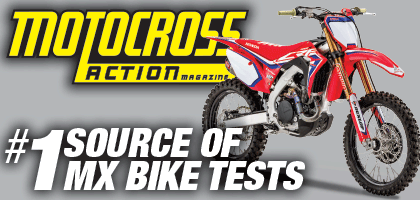BARE BONES: HOW TO TEST YOUR BIKE’S SUSPENSION
By Bones Bacon
Every motocross racer has the ability to become a test rider—maybe not a professional test rider for a manufacturer or a magazine, but certainly for his own bike. It is a valuable experience to spend some track time getting familiar with your bike, finding out what changes you can make to it, getting it dialed in to suit your riding style and adjusting it for various terrain. Every racer should look at his bike with a critical eye and spend some time in the saddle testing different settings. There is one caveat about testing: Don’t get too carried away with making changes. As Ricky Carmichael often told me when we were testing together, “You can tune yourself to a standstill if you’re not careful.”
“THE KEY THINGS YOU NEED TO KNOW ABOUT SETTING UP YOUR BIKE’S SUSPENSION ARE TWOFOLD: (1) YOU ARE NEVER GOING TO MAKE THE BUMPS DISAPPEAR. (2) THERE IS NO SUCH THING AS A PERFECT BIKE.”
Support riders ask me all the time to go testing with them. Most of the time I tell them that if I have done my job correctly, I shouldn’t have to. For most situations I feel like I have enough real-world experience to be able to set up a bike the first time and have it dialed in. When new bikes come out I put in a lot of time testing to get familiar with them. I work with a wide range of test riders to find the best all-around settings for riders of different weights, skill levels, ages and desires.
I have worked with riders who have no experience at all, minicycle racers, Novices, Amateurs about to turn Pro, freshly minted AMA Pros and seasoned professionals who know exactly what they want a bike to do. When I’m not working on the Pro Circuit team bikes, I am at many different types of races. My life goes from Supercross to motocross to desert to hare scrambles to GNCC to EnduroCross to Baja in a never-ending cycle of racing. I test so that I can find the best settings for the complete spectrum of offroad riding, and I believe that if you provide me with an honest evaluation of your weight, skill, track type and desires, I can get you very close to the best all-around suspension setup. I have faith that any reputable suspension shop, especially if the mechanics have experience with a large number of riders and situations, can do the same thing. Thus, I don’t always feel that a rider needs his suspension technician to go testing with him. All he needs is a screwdriver and some time.
The key things you need to know about setting up your bike’s suspension are twofold: (1) You are never going to make the bumps disappear. (2) There is no such thing as a perfect bike.
Years ago, I came to the understanding that if I made a rider’s suspension work better, he would just go faster until it didn’t work again. At times I wish that I were an engine tuner, because it is possible to make a bike so fast that the rider wants it slowed down. Not so with suspension.
What should you hope for from your personal testing program? You want to get your bike tuned to the point where you are comfortable. You want to achieve a synchronistic balance between the front and rear. You want a solid understanding of what your bike will do and what it won’t do (because there are bumps that can’t be conquered with 12 inches of travel). And, most important, you want to know when to stop adjusting your suspension. How do you know when this is? It’s very simple. Stop messing with it once you’re comfortable. You will get to know your bike and become a better rider if you follow this guideline. I have had both Jeremy McGrath and Ivan Tedesco tell me that they didn’t want to test any more to try to make their bikes better. They both said that their bikes were fine and that they just wanted to be left alone to get used to what they had.
The fundamental word to remember about riding a motocross bike across rough ground is “adapt.” Tracks change virtually every lap. You can’t pull in to add a couple clicks, because two laps later you’ll have to pull in again. You need to learn to adapt to changing conditions. I have worked with racers who would pull off a practice track to change the clickers as the track got dry, then be back in after the track was watered. Typically, by the time I was finished making the changes they wanted, the track had swung the other way. The average race starts with a slightly over-watered track, which becomes very loamy after a couple laps and then, towards the end of the moto, gets rough. The very best riders learn to adapt their riding styles and lines to the conditions at hand.
Truth be told, testing is important because it teaches you how suspension changes will affect your bike. But once you go to the starting line, you have to be willing to dance with the one who brought you to the party. Live, learn, adapt and enjoy.






Comments are closed.